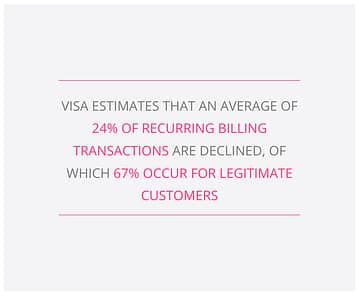Introduction
As subscription businesses rely heavily on credit cards for recurring payments, they are particularly susceptible to disruptions within the card payment system. Any glitch in this system can lead to involuntary churn, a silent killer of customer relationships.
Surprisingly, many subscription companies remain unaware of the systemic issues that lead to authorization errors, which disproportionately impact recurring payments. While the magnitude of these errors can vary, they pose a universal challenge: according to Visa, 24% of recurring billing transactions are declined, with 67% of those declines being false. The Aite Group estimates that these false declines resulted in a staggering $443 billion in lost revenue for merchants globally in 2021.
This guide is designed to equip subscription businesses with the knowledge to identify, quantify, and address this costly problem.

Unraveling the Impact of Failed Payments
Visa's data reveals that two-thirds of failed payments stem from false declines, where legitimate credit card transactions are wrongly rejected.
The payment authorization ecosystem is tasked with two primary goals:
- Approving all legitimate transactions.
- Declining fraudulent or otherwise undesirable transactions.
Given the immense scale and complexity of this system, which must make decisions in milliseconds, banks are increasingly erring on the side of caution to mitigate the $28.6 billion they lost to fraud in 2020. This cautious approach results in false-positive declines, or false declines, that can severely impact subscription businesses.
The effects are twofold:
- High Failure Rates: On average, 24% of subscription payment requests are declined.
- Churn: A false decline that isn't resolved ends the customer relationship.
RESEARCH SHOWS THAT PAYMENT FAILURES CAUSE UP TO 48%
OF ALL SUBSCRIPTION BUSINESS CUSTOMER CHURN
Involuntary Churn: The Hidden Threat
In subscription businesses, customer retention is paramount. Understanding the types of churn and tailoring your strategies accordingly is crucial.
Churn can be categorized into:
- Voluntary Churn: When customers actively choose to cancel their subscription.
- Involuntary Churn: When payment issues lead to unsuccessful transactions, resulting in lost customers.
Involuntary churn, primarily driven by failed payments, accounts for up to half of all churn. The good news? It's preventable. By identifying, managing, and reducing involuntary churn, you can significantly enhance retention.
Recognizing the Symptoms of Payment Failures
Assessing the Cost: Determining the extent of involuntary churn starts with data collection. This process might require additional reporting and the integration of new data sources, but the task itself is straightforward.
Begin by forming a small team from finance, technology, and reporting departments to gather the following data:
- Total churned customers.
- Customers affected by failed payments.
- Average customer lifespan (in billing cycles).
With these three data points, you can calculate the percentage of churn due to failed payments and quantify the financial impact on your business.
Calculating Recovery Benefits: Just as crucial as understanding the cost of failed payments is recognizing the value of recovering a customer post-failure. A recovered customer continues to contribute to your revenue over time, enhancing their lifetime value (LTV). By optimizing recovery solutions, you can maximize LTV and extend the lifespan of your customers.
Collect the following data to measure the value of recovered customers:
- Recovered customers (via retries or new payment details).
- Failed payment records.
- Successful billings post-recovery.
These insights will highlight the long-term revenue gains from effective payment recovery efforts.
Leveraging Technology and Best Practices to Curb Involuntary Churn
Technological Solutions:
Top-tier recovery systems employ customized strategies for each failed payment. By considering factors like the issuing bank, the reason code for the decline, and the type of credit card used, AI-powered solutions can offer tailored recovery approaches. These technologies typically yield the highest recovery rates.
Retention and LTV Strategies:
To truly minimize churn, your recovery efforts must focus on both immediate recovery and sustained customer retention. The longer a customer stays post-recovery, the higher their LTV. Delivering a positive customer experience during the recovery process is essential to achieving this.
Optimized Recovery Processes:
Certain payment failures, such as those due to expired or invalid card numbers, require direct customer intervention. However, notifying customers about a payment failure can sometimes lead to churn. The most effective recovery methods minimize customer involvement by resolving issues directly with the payment system. When customer action is necessary, a collaborative and empathetic approach is crucial.
Conclusion
Effectively managing involuntary churn by addressing payment failures can give your subscription business a significant competitive edge. By implementing advanced recovery strategies and optimizing customer experiences, you'll not only recover lost revenue but also strengthen customer loyalty and boost long-term profitability.
If you have any questions or want to explore tailored solutions for your business, contact us for a complimentary consultation.

